Jump to Ingredients – Jump to Method – Jump to Printable Version
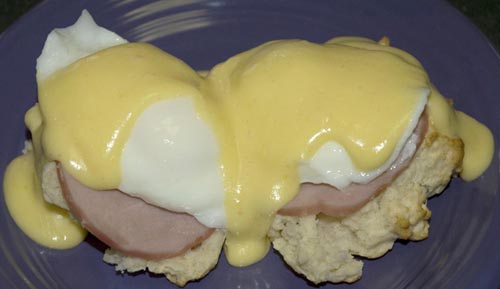 I don’t know who is spreading around those nasty rumors about hollandaise sauce but I am here to tell you that they aren’t true! In my opinion hollandaise sauce is one of the easiest and fastest sauces to prepare. It has even become one of my lazy day sauces for times when I don’t feel like putting much effort into cooking. The beauty of hollandaise is that there is basically no guess work involved. The recipe is a fairly specific formula and once you have it down you can do it with your eyes closed. You can buy imitation hollandaise in a packet but the velvety smooth texture and delicate tang of the real thing is more than worth the minuscule effort required to prepare it from scratch. Of course as with just about any recipe there are countless variations, but this is a very basic and absolutely perfect version of this classic sauce. Also, I want to mention that my preparation of hollandaise sauce involves cooking the egg yolk. Some preparations use raw egg yolk. I like to cook the egg yolk because with the method that I use, the resulting sauce is thicker than if made with raw egg yolks. I am comfortable with consuming raw eggs but I understand why people may have an aversion to it. So rejoice! If raw eggs aren’t your thing than you can still make fresh hollandaise using this recipe.
I don’t know who is spreading around those nasty rumors about hollandaise sauce but I am here to tell you that they aren’t true! In my opinion hollandaise sauce is one of the easiest and fastest sauces to prepare. It has even become one of my lazy day sauces for times when I don’t feel like putting much effort into cooking. The beauty of hollandaise is that there is basically no guess work involved. The recipe is a fairly specific formula and once you have it down you can do it with your eyes closed. You can buy imitation hollandaise in a packet but the velvety smooth texture and delicate tang of the real thing is more than worth the minuscule effort required to prepare it from scratch. Of course as with just about any recipe there are countless variations, but this is a very basic and absolutely perfect version of this classic sauce. Also, I want to mention that my preparation of hollandaise sauce involves cooking the egg yolk. Some preparations use raw egg yolk. I like to cook the egg yolk because with the method that I use, the resulting sauce is thicker than if made with raw egg yolks. I am comfortable with consuming raw eggs but I understand why people may have an aversion to it. So rejoice! If raw eggs aren’t your thing than you can still make fresh hollandaise using this recipe.
This recipe will yield about 1 cup of hollandaise sauce.
-Ingredients-
2 Egg Yolks
I use large eggs.
3/4 cup Unsalted Butter
Melted of course. The white foam that you can see on the butter is whey protein. This is ordinary unclarified butter, just the way it would be if melted down from solid butter. A lot of hollandaise sauce recipes call for clarified butter. This one does not. If, however, you do choose to use clarified butter you will need to thin the finished hollandaise sauce with a little water because it will end up with a texture like mayonnaise. Some people like their hollandaise sauce the texture of mayonnaise, however, so if you are in that camp then you will not have to thin it. I like my hollandaise thick and rich, but still pourable, like the consistency of a thick gravy. That is what you will end up with if you use unclarified butter. The choice is yours.
1 tablespoon Fresh Lemon Juice
Generally the juice of half of a small lemon will equal about a tablespoon. It is very very important that you use FRESH lemon juice! Do NOT use bottled lemon juice. I made the mistake of using bottled lemon juice once and the resulting sauce was putrid tasting. Use fresh. I have heard of people using lime juice as a substitute with good results, though the lime flavour is pronounced, so if that will work for the dish that you are preparing, then feel free to try it.
small dash of Cayenne Pepper
Cayenne pepper is what I use and is the most popular pepper to use. White pepper comes second. Use either one.
pinch of Salt
Salt to taste. I usually just put a pinch in and am happy with the results but some people like to use a bit more. Feel free to experiment. I use sea salt but ordinary table salt will work too.
-Method-
First you must melt your butter, juice your lemon, and separate the egg yolks from the whites. Place the yolks into a stainless steel bowl or small saucepan. You can reserve the whites for another use.
Pour the 1 tablespoon of fresh lemon juice into the bowl with the egg yolks.
Now you must cook the egg yolks until they are thick and smooth. You can use the classic approach and set up a double boiler (boil a pot of water and place the bowl or smaller saucepan on top of the pot with the gently simmering water, creating a gentle heat for the eggs to cook in) or you can use Chef John‘s approach and simply hold the bowl a couple inches over the burner. This is the way I always do it (I learned it from Chef John) and it really is quick and easy! So if you are going to do it the way I do then you will want to put an oven mitt on or at least hold the bowl with a dry cloth. Whisking vigorously hold the bowl an inch over a burner that is on medium low to low heat. This works with a gas or electric stove. If using gas I would recommend a lower setting and if using electric make it medium low and give the stove a minute to heat up before you begin the cooking process. Let the eggs cook slowly. Lift the bowl a little here and there to give the eggs a break from the heat while constantly whisking. You want to be careful not to scramble the eggs.
This whole cooking process will only take about two minutes. Before you know it you will have a mixture that looks like the picture below. You will notice that the mixture starts to resist the whisk slightly more and it will be thick enough that it sort of coats the bottom of the bowl when its tilted. Also when you lift the whisk out of the mixture some of it will stick to the whisk and fall back into the bowl in ribbons. The main indication that the yolks are fully cooked, however, is the presence of steam. The moment you see a small wisp of steam coming out of the bowl take it off of the heat. It is fully cooked. Even after taking it off of the heat keep whisking. There is enough residual heat on the bowl that it will still be cooking and at this point the eggs are very close to scrambling. So give it another good 30 seconds of whisking to help it cool off a bit, then get ready to emulsify the butter!
Put the bowl down on a towel or wooden cutting board, or anything that can withstand heat, because the bowl will still be hot (in the picture you can see that I put it onto a plate). Now it is time to emulsify to butter into the egg yolk mixture. This is easy as pie so don’t let all those horror stories worry you. The important thing here is patience. Whatever you do, do NOT dump all that butter into your egg mixture and whisk away thinking that someday it will emulsify. It never will. So what you must do is pour a little tiny bit of butter into your egg mixture. Lets say for now add about a teaspoon. Do not measure, that would be a waste of time, I’m just giving a rough estimate here. Now WHISK! WHISK! WHISK! quickly, until all the butter is incorporated. Add a bit more, again a tiny amount. WHISK! WHISK! WHISK! Add another tiny amount. WHISK! WHISK ! WHISK!
Ok its a little tedious, sure, but its not hard. It just takes a bit of patience. Seriously though the whole process doesn’t even take very long. I’d say it takes me around 8 minutes to make this recipe from start to finish. And really, its mindless work. Get into a rhythm and DON’T get impatient and try to cheat by adding more butter than you should, or you will be sorry.
After you have made a few (lets say…. 6 or so) of these initial tiny butter additions and thoroughly whisked them in, you can get a bit braver and start adding a little more at a time, like a tablespoon or so. Continue adding approximate tablespoons and whisking thoroughly until you have used up all of the butter.
You now have hollandaise sauce! That wasn’t so bad was it? The texture should be smooth and creamy with no hint of oiliness and no chunks. It should be very thick but pourable, perhaps just barely pourable, and it is perfect. Now all that remains is to season it.
Add a dash of cayenne pepper and a pinch of salt (or to taste) and mix into the sauce. ( I did not include it in the recipe but sometimes I like to add a dash of Worcestershire sauce as well, Especially if I am using the Sauce for a more flavourful dish, like Chicken Florentine or a beef dish of some kind. I would not add it for a more delicate dish like Eggs Benedict or fish.)
Now take a moment and appreciate the majesty of your creation. See how it coats the spoon? Lovely!
Serve your hollandaise immediately. Do not reheat. It is meant to be eaten only lukewarm. The unfortunate thing about hollandaise sauce is that it cannot really be stored. You have to make it right before you want to eat it. If you try to chill it the emulsification will break and you will be left with an oily liquidy mess. So only make what you intend on using right away. The sauce will last at room temperature for up to an hour generally before it breaks. If it does break, one trick is to get a bowl with about a tablespoon of warm water and slowly add the broken sauce into the water. It should re-emulsify by doing this. If you want to keep the sauce handy for more than an hour you can set up a double boiler and keep the water warm but not hot and keep the hollandaise sauce on top of the water to maintain the proper temperature (which is just a little warmer than body temperature). I never have to worry about any of that stuff though because I usually use my sauce right away.
(*EDIT* Someone who commented on the reddit post for this recipe mentioned that you can use a warmed thermos for slightly extended storage as well. Great tip! Basically as long as you keep the sauce at the correct temperature, which is just slightly warm to the touch, then it will keep for a while.)
So I know I got fairly long winded with explanations because there ARE some things you have to keep in mind when making and using hollandaise sauce, but that does not mean that it is difficult. You will find that the process is far less complicated than it seems at first. Just try to make it once and you will be hooked. I guarantee it. Knorr will rue your new discovery. No cheap knock off can match the quality of the real thing.
Let your Eggs Benedict know that you care.
Show your Chicken Florentine a good time.
After all, they do so much for you.
**Additional tip: You can make a raw version of hollandaise sauce using this exact same technique and recipe with two differences; Do not cook the egg yolks, and use CLARIFIED BUTTER. Using unclarified butter along with raw egg yolks will create a runny hollandaise sauce. It will still taste good, but hollandaise sauce should be thick.
-Printable Version-
HOLLANDAISE SAUCE
Ingredients:
2 Egg Yolks
3/4 cup Unsalted Butter
1 tablespoon Fresh Lemon Juice
small dash of Cayenne Pepper
pinch of Salt
Method:
1. Melt your butter, juice your lemon, and separate the egg yolks from the whites. Reserve the whites for another use, and put the yolks into a stainless steel bowl or small saucepan.
2. Pour the 1 tablespoon of fresh lemon juice into the bowl with the egg yolks.
3. Place the bowl over a gentle heat (either by using a double boiler, or simply holding the bowl over the stove burner set at low to medium low heat. If using the latter approach be sure to use an oven mitt or rag to hold the bowl because it will become hot). Constantly whisk the yolks while allowing the heat to rise slowly. The eggs will cook and thicken in one to three minutes if using the second approach. If using a double boiler it will take a little longer.
4. Once the yolks are thickened and you can see small wisps of steam rising out of them take the bowl off of the heat immediately and continue to whisk quickly for at least another 30 seconds in order to keep the yolks from cooking too much.
5. Now add a small amount of melted butter (around a teaspoon) and whisk it in quickly. Add another teaspoon and repeat a few times. No need to count an exact amount but do this at least 6 times or so.
6. After you have gotten the emulsion going you can start adding a little bit more in between whisks. About a tablespoon at a time will work. Continue adding the butter one tablespoon at a time and whisking to incorporate thoroughly until all of the butter is used up and you have a thick smooth sauce.
7. Add a dash of cayenne pepper and a pinch of salt (or to taste) and mix into the sauce well.
8. Do not heat or chill the sauce. Serve immediately after preparing.

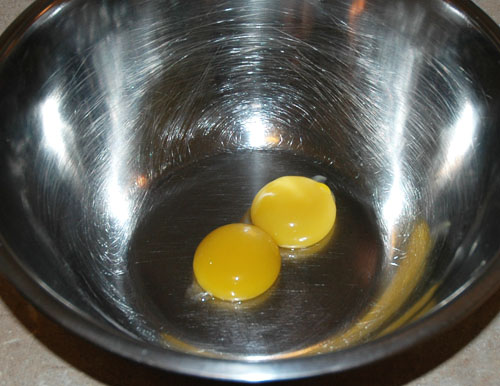
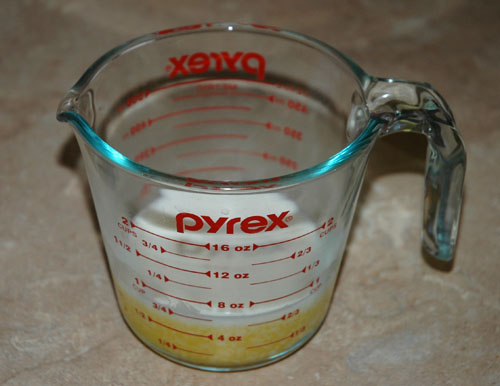
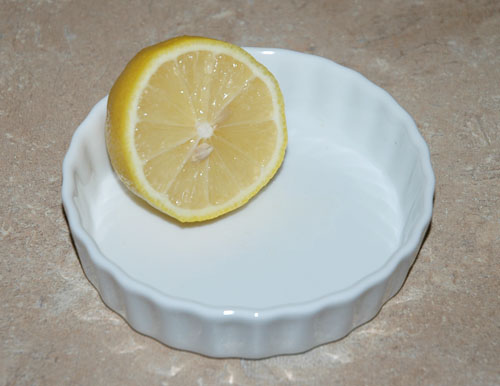
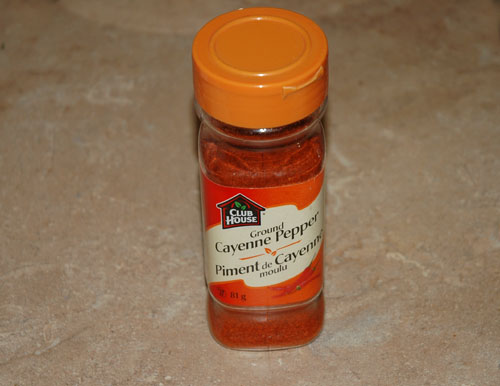
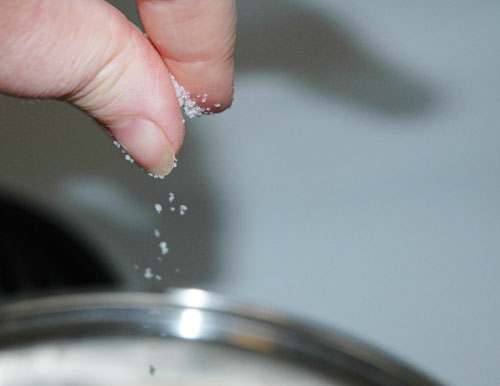
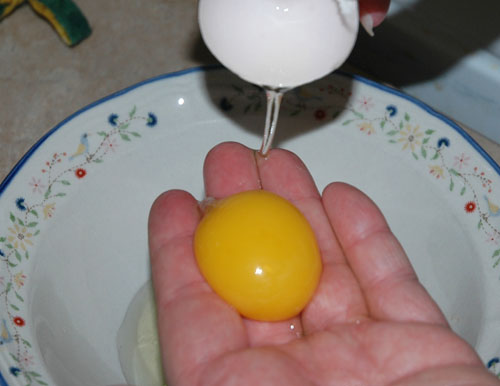
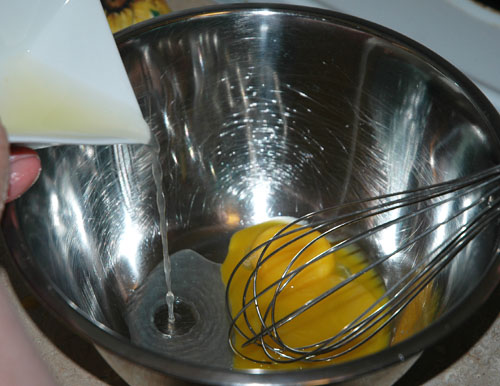
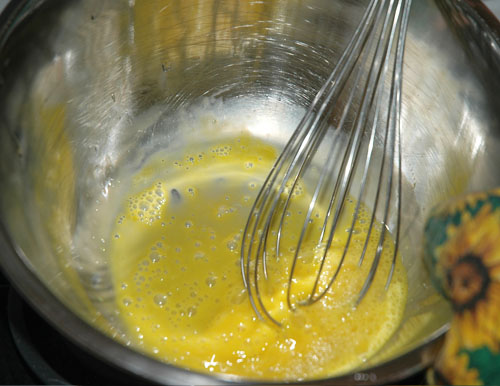
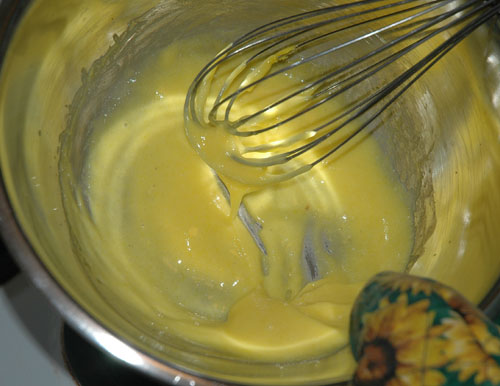
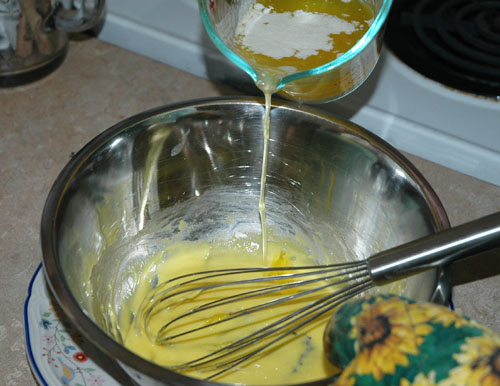
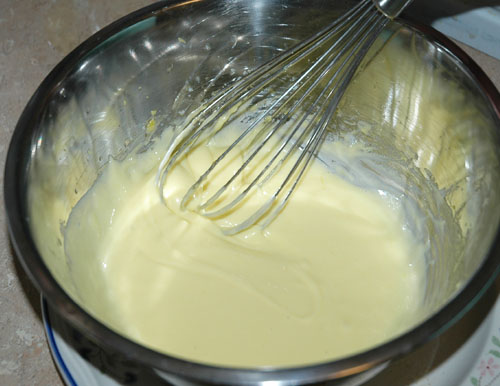
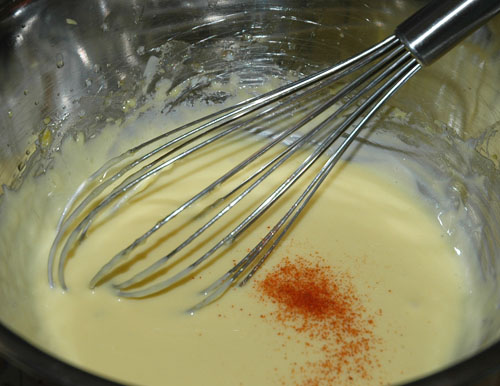
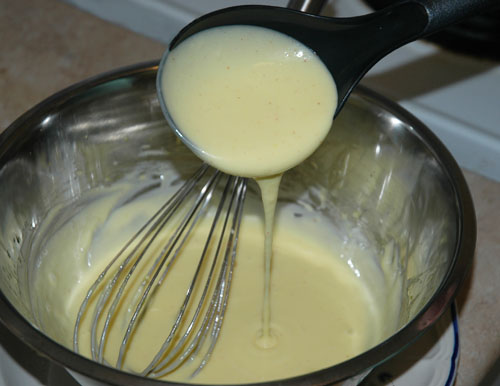
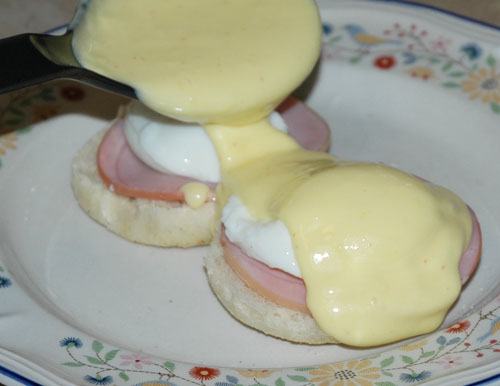
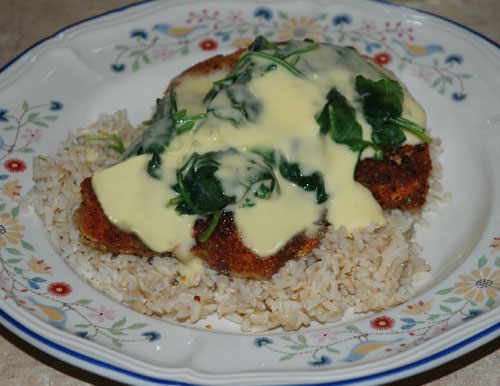
Pingback: Eggs Benedict | The Cooking Geek()
Pingback: Mayonnaise | The Cooking Geek()
Pingback: Chicken Florentine | The Cooking Geek()
Pingback: Food Log – August 12, 2013 - Whateverisonmymind()
Pingback: How To Make Hollandaise Sauce | In My Messy Kitchen()
Pingback: How Many Calories In Hollandaise Sauce | Everything about Calories()
Pingback: How Many Calories In Hollandaise Sauce | How Many Calories are in...()